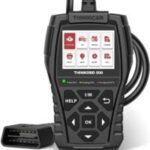The OBD2 code P0300 signals a random or multiple cylinder misfire in your vehicle’s engine. This trouble code indicates that one or more cylinders are not firing correctly, which can lead to a variety of performance issues and potential engine damage if left unaddressed. It’s crucial to understand what this code means and how to diagnose and fix the underlying problem to keep your car running smoothly.
Symptoms of a P0300 Code
While the check engine light illuminating is the most obvious sign, there are several other symptoms you might experience when the P0300 code is triggered:
- Rough idling: The engine may vibrate or shake noticeably when the car is stationary.
- Decreased engine power: You might notice a lack of acceleration or sluggish performance.
- Poor fuel economy: Misfires can reduce the engine’s efficiency, leading to more frequent trips to the gas station.
- Hesitation or stalling: The engine might hesitate during acceleration or even stall unexpectedly.
- Unusual noises from the engine: You may hear popping or sputtering sounds.
Common Causes of OBD2 Code P0300
Several factors can contribute to a P0300 code. Identifying the root cause is essential for effective repair. Here are some of the most common culprits:
- Worn or fouled spark plugs: Spark plugs are crucial for igniting the air-fuel mixture in the cylinders. Worn or dirty spark plugs can cause misfires.
- Faulty ignition coils: Ignition coils provide the high voltage spark needed for ignition. A weak or failing coil can lead to misfires in the affected cylinder.
- Clogged or malfunctioning fuel injectors: Fuel injectors are responsible for delivering the correct amount of fuel to each cylinder. Blocked or failing injectors can disrupt the fuel supply and cause misfires.
- Vacuum leaks: Vacuum leaks can disrupt the air-fuel mixture, leading to misfires.
- Low fuel pressure: A weak fuel pump or a clogged fuel filter can cause low fuel pressure, resulting in misfires.
- Carbon buildup on intake valves: Excessive carbon deposits can interfere with airflow and cause misfires.
- Exhaust leaks: While less common, exhaust leaks can sometimes contribute to misfires.
- Timing issues: Incorrect engine timing can also lead to misfires.
- Cylinder head gasket failure: In more serious cases, a blown cylinder head gasket can cause compression loss and misfires.
Diagnosing and Fixing the P0300 Code
Diagnosing a P0300 code typically involves a systematic approach:
- Use a Scan Tool: Connect an OBD2 scan tool to your vehicle’s diagnostic port. This will confirm the P0300 code and check for any additional codes that might pinpoint the affected cylinder(s) or system.
- Inspect Spark Plugs: Examine the spark plugs for wear, damage, or fouling. Replace them if necessary, especially if they are old or appear to be the source of the misfire.
- Test Ignition Coils: Test the ignition coils using a multimeter or a specialized coil tester. Replace any faulty coils.
- Check Fuel Injectors: Listen to the fuel injectors with a stethoscope or use a noid light to check if they are firing. Fuel injector cleaning or replacement may be required.
- Perform a Compression Test: A compression test can help identify mechanical issues like valve problems or a cylinder head gasket leak.
- Check for Vacuum and Exhaust Leaks: Inspect vacuum lines and exhaust components for leaks. Repair any leaks found.
- Verify Fuel Pressure: Check fuel pressure to rule out fuel pump or fuel filter issues.
Depending on the diagnosis, fixing a P0300 code might involve replacing spark plugs, ignition coils, or fuel injectors. Repairing vacuum or exhaust leaks, addressing timing issues, or even more complex repairs like replacing a cylinder head gasket might be necessary.
Can You Drive with a P0300 Code?
While your car might still be drivable with a P0300 code, it’s not advisable to drive for extended periods without addressing the issue. Continuous misfires can lead to:
- Catalytic converter damage: Unburnt fuel entering the exhaust system can overheat and damage the catalytic converter, a costly repair.
- Increased engine wear and tear: Misfires put extra stress on engine components, potentially leading to more significant damage over time.
It’s best to diagnose and repair the P0300 code as soon as possible to prevent further damage and ensure your vehicle’s longevity and performance. Consulting a trusted mechanic is recommended if you are not comfortable performing these diagnostic and repair steps yourself. Keep your Haynes manual handy as a guide during the diagnostic and repair process.
Once the repairs are completed, use a scan tool to clear the fault codes and ensure the check engine light is off.
